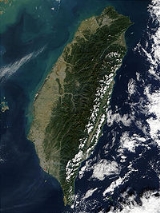
in the western Pacific Ocean
and located off the southeastern coast of mainland China
. The island forms over 99% of the current territory of the Republic of China
(ROC) following the Chinese Civil War
in 1950. Due to this reason and the disputed political status of Republic of China
in the United Nations, the name "Taiwan" has also become the pars pro toto
common name for the country itself.
1635 Dutch colonial forces on Taiwan launch a pacification campaign against native villages, resulting in Dutch control of the middle and south of the island.
1652 Around 15,000 Han farmers and militia rebel against Dutch rule on Taiwan.
1662 The Chinese general Koxinga seizes the island of Taiwan after a nine-month siege.
1683 The Qing Dynasty naval commander Shi Lang reaches Taiwan (under the Kingdom of Tungning) to receive the formal surrender of Zheng Keshuang and Liu Guoxuan after the Battle of Penghu.
1895 The Treaty of Shimonoseki between China and Japan is signed. This marks the end of the First Sino-Japanese War, and the defeated Qing Empire is forced to renounce its claims on Korea and to concede the southern portion of the Fengtien province, Taiwan and the Pescadores Islands to Japan.
1945 The Republic of China takes over administration of Taiwan following Japan's surrender to the Allies.
1947 228 Incident: In Taiwan, civil disorder is put down with the loss of 30,000 civilian lives.
1949 The Kuomintang regime declares martial law in Taiwan.
1949 Chinese Civil War: The People's Liberation Army begins its siege of Chengdu, the last Kuomintang-held city in mainland China, forcing President of the Republic of China Chiang Kai-shek and his government to retreat to Taiwan.
1964 The Republic of China (Taiwan) breaks off diplomatic relations with France.

